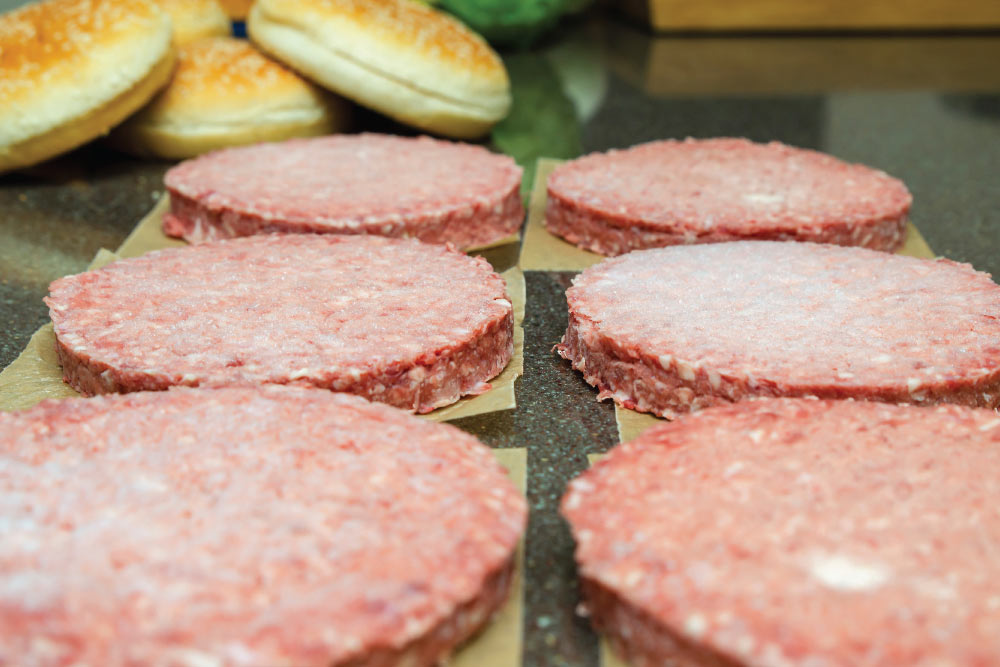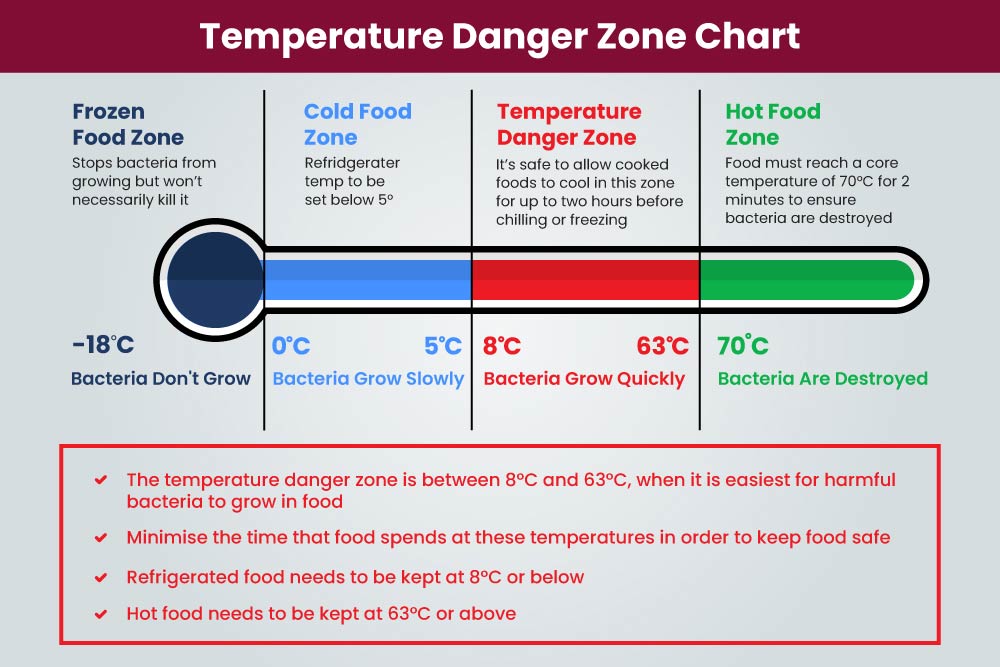
Certain foods are dangerous when not stored properly or fully cooked before serving. You almost definitely know this already. You’ve probably also got a good idea of how to check foods are safe.
But most common methods are little more than an educated guess. You can follow use-by dates, sniff food or check that juices are running clear. However, none of these strategies are foolproof.
If you want to be sure, you’ve got to know the Temperature Danger Zone.
If you’re a food professional or want to be more precise regarding food safety, read this guide. It explains the Danger Zone and how to keep food out of it.
What is the Temperature Danger Zone?
The Temperature Danger Zone is 8 to 63 degrees Celsius. You need to keep food out of this temperature range to ensure safety.
Harmful bacteria will likely multiply on food products between 8°C and 63°C. This makes it necessary to store foods at low temperatures, which limits the growth of bacteria, and cook them at high enough temperatures to kill off bacteria before eating.
The Danger Zone is set by the Food Standards Agency (FSA), responsible for food safety in England, Wales, and Northern Ireland. (Scotland has slightly different temperature guidance, but the principles are the same.)
Food Safety Risks
All foods can harbour potentially harmful bacteria that cause foodborne illness when ingested. The bacteria might be present in the produce or the result of cross-contamination, but no food is entirely without risk.
This risk is much greater when food is stored at an unsafe temperature or served without adequately cooking.
For example, common bacteria such as Clostridium perfringens, which causes diarrhoea, thrive in food at room temperature.
Other microbes, such as E. coli, often survive cooking if temperature guidelines aren’t followed.
Keeping food out of the danger zone is the best way to prevent harmful microbes from reaching your plate.
How to Keep Food Safe
Store foods below 8°C and cook them above 63°C. However, there are other food safety guidelines you should be aware of.
Cooking
Cooking foods thoroughly at a high enough temperature is the best way to kill off harmful bacteria.
Although the upper end of the danger zone is 63 degrees Celsius, the FSA states slightly higher cooking temperatures are necessary to ensure food safety.
At a minimum, food should reach a core temperature of 70°C for two minutes. Unless the core (i.e. the middle) of the food reaches a high enough temperature, there’s still a risk bacteria may survive the cooking process.

Although 70°C is the standard, you can vary the cooking time or temperature to achieve the same effect. Cooking food at a lower temperature for longer can be effective and, as you’d imagine, cooking foods at higher temperatures for shorter periods can also be safe. You can read the full range of approved temperature and cooking time combinations here.
To ensure food is cooked throughout, you should use a probe thermometer. These thermometers allow you to get a temperature reading from the core of the food, but be sure you take readings from the middle or thickest part of the produce. You must also thoroughly clean the probe between uses to prevent cross-contamination.
Storage
For safe storage, refrigerate food below 8°C or freeze if possible.
Chilling and freezing aren’t the same as cooking, however. As the FSA puts it, freezing is a “pause button.” It stops bacteria from growing but won’t necessarily kill it.
You should keep fridges at 5°C or cooler to ensure chilled food stays out of the Danger Zone. You should confirm this temperature with a fridge thermometer, as you can’t always rely on the accuracy of in-built fridge controls or temperature dials.
It’s also important to avoid overcrowding. Internal temperatures can rise if air can’t circulate around your fridge, so only chill food items recommended for refrigeration.
Freezing food keeps it safely out of the Danger Zone, but there are a few things to remember. Only freeze foods before expiration dates have passed, and check the packaging to confirm any pre-made foods are suitable for freezing.
If you’re freezing leftovers, place them in an airtight container or freezer bag first. You must also ensure that cooked foods have cooled thoroughly before freezing them.
Cooling
Since cooked food should cool down before chilling or freezing, it will pass through the Temperature Danger Zone.
It’s safe to allow cooked foods to cool at room temperature (right in the Danger Zone) for up to two hours before chilling or freezing. This is the maximum length of time that cooked foods can be kept safely at room temperature and it’s better to get food below 8°C as quickly as possible.
Putting warm food into the fridge before it’s thoroughly cooled won’t make it unsafe. Still, it can potentially spoil other chilled items. Warm foods can heat the interior of your fridge, which might be enough to bring the internal temperature above the recommended 5°C threshold. So, allowing warm foods to cool entirely before refrigerating them is always safer.
Defrosting and Reheating
Defrosting food at room temperature puts it in the Danger Zone, so it’s recommended to thaw food in the fridge. You should also be sure that defrosting foods are in a container to prevent drips onto other products, which can cause cross-contamination.

Check foods are entirely defrosted before cooking, too. Partially frozen foods cook unevenly, which may prevent the core temperature from reaching the necessary 70°C. (You can cook frozen meat; just be sure the core temperature gets hot enough.) Any defrosted foods need to be cooked and eaten within 24 hours.
Reheating
Reheating foods can also be hazardous if not done correctly. Reheating means repeating the cooking process, i.e. getting foods back up to 70°C for at least two minutes. You can’t just warm up a previously cooked food item or dish.
Thoroughly reheating food should always kill any bacteria, but the FSA still only recommends reheating food once. Chilling and then reheating food multiple times gives bacteria more opportunities to grow. It becomes harder to guarantee food is safe if it’s repeatedly changed temperature. Reheating food more than once often affects the taste, too.
Free Food Safety Chart
Download this free Temperature Danger Zone chart so you can refer to it in future or share it with your team.

Food Hygiene
Understanding the Temperature Danger Zone is essential for anyone preparing food, but it’s not the only knowledge professionals need. Food hygiene training is required for anyone handling food in a working kitchen.
Our online Food Hygiene Courses cover everything you need to know to safely work with food – cooking, handling, storage and hygiene. It explains your food safety duties and gives you a recognised training certificate to prove you understand the fundamentals of safe food preparation and hygiene standards.





















































































































































































































































































































































































































































































































































































































































































































































